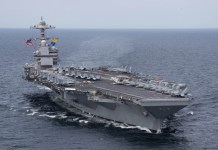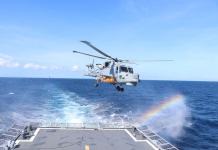Recently declassified files of a US intelligence agency reveal details of one of the earliest supersonic spy drones, which was sent on a secret mission and never returned.
Race To Build The Most Potent ‘Flying Car’ Heats-Up; Is India Ready For The Revolution?
The National Reconnaissance Office declassified some documents that highlight a US program to develop a spy drone in the 1960s to prevent the risk of sending manned spy planes like the U-2 over hostile territory.
The D-21 was straight out of science fiction. Built by Lockheed Martin with the support of the US Air Force, the drone was capable of flying at Mach 3.3 speed, reaching unreachable altitudes of 95,000 feet, and could traverse 3,000 nautical miles on its outward and return journey.
The Earliest Drones
The D-21 was one of the earliest unmanned aerial reconnaissance vehicles designed specifically for collecting photo evidence of China’s nuclear sites.

Patrick Widlake, Chief Researcher of NRO’s Center for the Study of National Reconnaissance, writes about the D-21 as a 43 feet long weighing 10,300 pounds drone composed of high-strength titanium alloy and high-temperature plastic materials.
It contained a recoverable payload “hatch” weighing 880 pounds that carried the camera for collecting photo evidence, a navigation system control, and other necessary electronics including a parachute recovery system to eject the film roll.
But D-21 wasn’t the only drone made during the Cold War era and the US wasn’t the only country experimenting with unmanned vehicles. The drones developed during the 20th century were different from the 21st-century ones. Most of them were large or medium aircraft operated as remote-controlled vehicles (RCVs).
In the 1930s, the British had developed a low-cost radio-controlled target aircraft called DH 82 B or the “Queen Bee” which had a wingspan over 29 feet (8 meters). It was initially designed to be used as an aerial target during training missions.
Later, a total of 380 Queen Bees served as target drones in the Royal Air Force and the Royal Navy until they were retired in 1947.
Similarly, US-based Ryan Aeronautical Company developed a series of target drones in the 1950s. It was one of the first jet-propelled drones that could be both air-launched or land-launched.
The Firebee I was the earliest model with multiple advanced variants like the BQM-34A or the MQM-34D. Later a “third-generation” Model 166 was launched and inducted into the US Air Force and Navy in the late 1960s.
Ryan built one of the most successful reconnaissance drones in the world, the FireFly and Lightning Bug, also known as “Model 147” which were extensively used in the Vietnam war.
What Happened To D-21?
The D-21 was part of a secret project called ‘Tagboard Project’, under which the US military aimed to send super-fast drones to spy on China’s nuclear program.
The D-21 was made to launch from the M-21, the CIA’s version of the iconic spy warplane Mach 3 SR-71. Later, due to technical glitches and a fatal crash, B-52H bombers replaced the M-21 as launch vehicles.
Rear view of an M-21/D-21 combo. This is from an early flight where aerodynamic shrouds were placed over the intake and exhaust of the drone. At the time this? was taken this was still a very secret program, ruling out the possibility of a civilian taking the picture. ?USAF/RR pic.twitter.com/tpQuQvz5a0
— J.J. (@kadonkey) January 30, 2021
The drone was fitted with a predefined flight path and a radio to maintain contact with the launch plane to monitor its activities.
After getting the shots of the hostile territory and the nuclear power plants that the Chinese were building, the D-21 was supposed to release the film roll and self-destruct.
The exposed film, fixed with a parachute, was to be caught mid-air by a transport plane like the JC-130 and or the Navy if it fell into the ocean.
In 1969, the D-21 was ready for its maiden spy mission. There were four missions in line but all of them were declared unsuccessful after failing to safely hand over the highly “classified files” to the US military.
The first two times, the D-21 drone crashed before collecting any photo evidence. In the third mission, launched in March 1971, the drone completed its surveillance run but failed to safely eject its film capsule.
A fourth attempt was launched later the same month but that too ended in failure as the drone crashed in China’s Yunnan province.
Despite the impressive features, the D-21 was short-lived as multiple crashes led to the program being scrapped in 1971. It was later revealed that one of the crashed drone models was recovered by Russia.
The US abandoned the program by mid-1971 and replaced the reconnaissance tasks with satellite-based intelligence collection which was an emerging spy tool during that time.

The story with the first D-21 drone took a peculiar turn when in the mid-1980s, Ben Rich, a Lockheed engineer who worked on the D-21, was given a metal panel by a CIA (Central Intelligence Agency) sleuth.
The plate was in fact a piece of the D-21 that had crashed in Siberia and had been recovered by a shepherd. The KGB, Russia’s intelligence agency, caught hold of the spy drone and later returned it to the CIA.
China also recovered the wreck of the fourth self-destructed D-21 and has put it on display in Beijing. For some experts, China’s DR-8 or Wuzhen 8 (WZ-8) spy drones bear some resemblance to the Cold War-era D-21.
Watch A Giant 3D Cat Atop A Tokyo Train Station Catches Commuters By Surprise
The Russian D-21?
Russian aviation historians Yefim Gordon and Vladimir Rigamant shared details about their country’s project on developing a supersonic strategic reconnaissance drone called “Voron” (Raven).
In the 1960s, Soviet Union was designing "Voron" (Raven) long-range supersonic UAV. It never saw the light of day. pic.twitter.com/mZjHJDxmp5
— Samuel Bendett (@SamBendett) September 30, 2019
Quoting the two, The National Interest said many leading enterprises and organizations of the aircraft, electronic, and defense industries were commissioned to study the design of the D-21 together with the materials used in its construction, its production technology, and its equipment.
Its operational mechanism was similar to the D-21 where the craft followed a pre-programmed flight path using an inertial navigation system. Once it returned to the base, the film canister would be ejected and land by parachute, after which the drone itself would land.
Later, much like the fate of the original D-21, Voron too fell victim to the network of spy satellites.
The NRO’s Center for the Study of National Reconnaissance remembers the legacy of D-21 as an “investment that taught valuable lessons that informed successful follow-on developments”.
Read More




